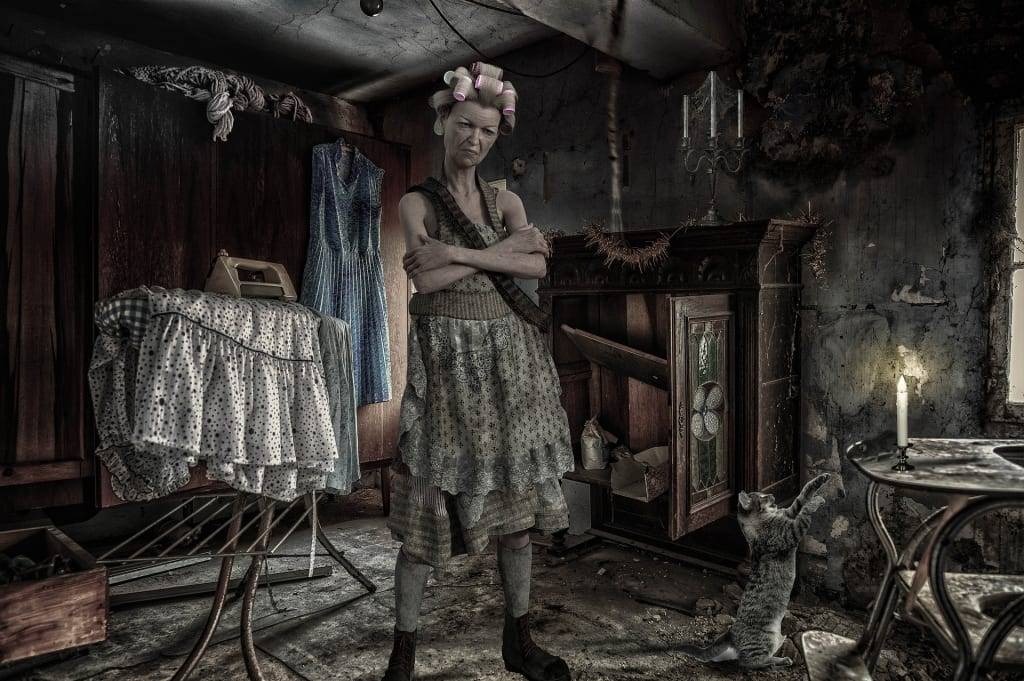When I watched Oprah as I was growing up, there was one thing I wanted more than anything else. I wasn’t interested in the days when she said ‘you get a car,’ and ‘you get a car’, or told the entire audience they were off on a cruise or to Sydney, Australia, or somewhere else. Sure, those things would have been nice but I knew fundamentally they weren’t going to fix my problem. Once I got back from my holiday, once I’d finished driving my car, I’d still be left with the same issue I’d always had – what to do about the mess and clutter that threatened to overtake my life. (Plus, I’d probably have a whole lot of holiday memorabilia to deal with and because of the amount of stuff we had the car mightn’t fit into the garage anyway.)
What I really wanted from Oprah was for her to send her clutter guru Peter Walsh to my house to fix things.
I longed for the moment when my family would feature in the after section of the show—the big reveal. I didn’t want to have to go through the embarrassment of the ‘before’ segments, I didn’t want anyone to see what the house looked like in its normal state, but I enjoyed imagining what it would be like when the house was clear of junk.
For a while I became a little obsessed with cleaning and clutter shows. The ones where ladies wearing white gloves came in to clean the oven or the families of extreme hoarders gathered for a weekend intervention of tossing and cleaning and arguing with one another.
I searched these shows for tips to help myself, hoping to find in them both inspiration and warning, but they never really did much good. In fact, they actually hindered my progress because they helped perpetuate some fallacies that you might recognize:
1. The Knight in Shining Armour myth. The idea that Oprah or a cleaning genie is going to suddenly appear and help you clean. This is magical thinking and it is never going to happen.
Some of you may be lucky enough to afford a professional organizer, or have a good friend or family member who can help, but ninety-nine times out of a hundred you are on your own. And think about this. How well would you actually cope with someone else looking at and dealing with your mess? I’ve watched enough shows to know how painful and real those tears are from the people being helped to remove stuff.
Takeaway: Clearing clutter is hard work and the only person you can rely on to do this is yourself. Even if you decide to get help, you have to actually organize the help, ask for it, or accept if someone offers. Once you stop dreaming and understand this, it is easier to take the first steps.
2. The Time myth. In the clutter shows there’s always a ticking clock. The clean-out has to be done in three days, or over a weekend, or before the County Sheriff comes to throw mum out into the street. It’s a trick to build narrative tension. No one would watch a show if there were no time limit and we had to spend months watching someone clear up.
Some cleaning gurus recommend this too. Pulling everything out and dealing with it all in one go. There was even one show called ‘Your life on the lawn,' where they emptied the contents of a house out into someone’s front yard. That’s fine if you have a relatively small area of clutter to clear – one room perhaps, or the space to put the junk and the resources or time to get it all done in one slog.
But in the real world most of us don’t have film crew or a set of removalists or specialist cleaners to help take our stuff somewhere else to sort.
And if we did, most of us don’t have the time or emotional energy to do the whole thing in one go, or the space to put our stuff while this was happening. For most of us, life and work and family has to fit in around our decluttering.
Takeaway: You don’t have to do the job in one go. In fact, in many cases, it’s impossible for you to do that. If you wait for the right circumstances and opportunity you’ll never begin. Instead, just start small. Do a few things in one spot and then move on and keep going. Start again the next day.
3. The ‘do it once and it’s done’ myth: This is the hardest one. In the clutter shows we see the state of the house before, we see the people rushing through the hard work in a frenzy to get the place done and at the end we get the payoff—the grand reveal, where everyone squeals and hugs and walks around showing off their clean and tidy house. Then the credits roll and we never get to see what happens next.
You may have already found this out for yourself, but the sad truth is that unless underlying issues, patterns and habits have been changed, most people who approach decluttering in a ‘one big hit mode’ revert to a similar level of chaos relatively quickly. That’s not to say you should get depressed and never start, but that you should approach it more slowly, concentrating on developing habits and changing your mind frame. Cleaning and decluttering need to be approached as ongoing activities, not one-off events.
Takeaway: Cleaning and decluttering need to be maintained every day. Like cleaning your teeth—they should happen at least once a day and preferably more often. Little and often is the key to progress.
Instead of making you feel depressed and hopeless, understanding that decluttering doesn’t have to happen all in one go can free you up to get started.
You remember the old saying about how to eat an elephant? One bite at a time. Freeing your house and life of clutter is the same. And if you’re like me and sometimes feel like you have a whole herd of elephants in your house it’s the only way to go.
Here’s my favourite tip to help get you started.
The 5 x 5. Set your timer for five minutes and go around the house decluttering and clearing mess for five minutes or dealing with five things – whichever takes longest.
How it works. You might make your bed and wipe down the bathroom sink and pick up and put away three items from the pile on the bedroom floor before the timer runs out. That’s five things. Or you might choose to address five items from the bundle of papers waiting in your ‘to be dealt with or filed away’ pile. Or spend five minutes looking in your wardrobe finding five things to donate or throw out. If the timer goes off while you’re half way through something, finish the task and you’re done. If you get your five things done before the timer goes, then start something else and keep going until it does.
Why it works. Everyone can manage five minutes. Often the hardest part about decluttering is getting started. You might be surprised at how much you can get done in a short space of time. Once you begin you may find it easy to continue beyond the five minutes. But limiting the time to five minutes or five items as your minimum effort means you don’t get overwhelmed.
It means you don’t go into the bathroom to wipe down the sink and then go into a spiral in your head that might sound something like this. ‘Oh, I need to clean the toilet too, and someone has tracked mud all over the floor and how long since I washed those curtains and I should sort out that drawer and I can hardly get the bathroom cabinet shut it’s so stuffed with things and the shower needs regrouting and what if I painted the walls a different colour…’ you get the idea! At that point you feel so overwhelmed you walk back out of the bathroom to make a cup of tea or start scrolling on your phone.
At this point I can feel you rolling your eyes and saying something like –
‘But what about all those other things that need doing? Five minutes will never be enough? And what about my overstuffed closet? If Oprah or the knight on horseback isn’t coming to do it, how will I ever get it done?’
Remember the elephant? No-one would consider eating the whole thing at once, but one bite at a time is all it takes. By starting off with five things or a five minute block you get a sense of achievement when you finish each 5 x 5 set. Our brains are very attuned to completing or accomplishing something, so it gives us a little hit of dopamine – the feel-good hormone to reward us. This means we’re more likely to repeat the activity or to keep going and we get into the habit of dealing with our clutter.
So when your brain goes into that spiral about all the things that need doing, just create a list and add them to it, and then the next time you’re ready to do your five minute stint you know where to start. And the thing about the five minute sets is that you can choose to do as many or as few as you like. You can package them together and do five sessions in a row, or spread out six sets across the day. It doesn’t matter if you do one or fifty sessions (which would be just over four hours, by the way,) the thing that matters is that you start somewhere and do something.
Go on. Get up out of your chair right now and have a go. It’s not a magic cure, but it’s a start. Oprah’s not coming to help so it’s up to you. And everyone can manage five minutes.


